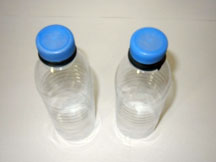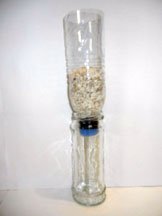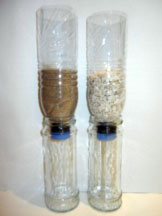Porosity and Permeability in Petroleum Reservoirs
This activity created in partnership with AGI.
The word petroleum means “rock oil” or “oil from the Earth.” Petroleum, also called crude oil, is a smelly, yellow-to-black liquid that is sometimes runny but can also be quite thick. When refined into specific fuels, it is used to power vehicles and heat homes. It also provides the chemical basis for plastics and other common products of modern life.
 Image courtesy of |
Petroleum forms from tiny animals and plants that lived in oceans and shallow seas hundreds of millions of years ago. As these plants and animals died, their remains sank and piled up on the sea floor. Over millions of years, the remains were covered by layers of mud and sand. Heat and pressure from these layers changed the remains into petroleum and turned the layers into rock. Later, the petroleum traveled sideways and upward from where it was formed to other rock formations or even to the Earth’s surface.
American Geosciences Institute, 2012.Underground areas that contain petroleum are called reservoirs. Only a certain kind of place is likely to be a petroleum reservoir. An essential characteristic of a petroleum-bearing region is a thick bed of sedimentary rocks. In addition, only certain types of sedimentary rocks can hold and transmit petroleum. Our animation shows you how petroleum forms and migrates into reservoirs.
Video ©American Geosciences Institute, 2012.
The video Oil Formation over Time shows how oil develops in rock layers.
Our Experiment
Petroleum reservoirs are associated with certain types of underground rock formations, which are not found in all places around the world. In addition, not all reservoirs hold the same volume of petroleum. An added complication is that petroleum flows out of some reservoirs much more easily than others.
In this activity, you will consider some of the factors that determine whether or not a sedimentary rock might be a good reservoir for petroleum. First, you will run a porosity experiment to determine whether sand or gravel can hold more cooking oil. This will help you to understand the types of rocks that best hold petroleum. Then, you will test the permeability of sand and gravel by allowing the oil to drip out of each container while tracking the time it takes. This will give you an idea about how much petroleum is actually recovered from a reservoir.
Tools and materials
- Two 500-mL (approximately 16-oz) clear plastic bottles
- Coffee filter
- Electrical (vinyl plastic) tape
- Two clear containers that can hold the plastic bottles when they are inverted. Empty jars, or plastic or glass cups, can be used.
- 200 mL (7 oz) of sand
- 200 mL of gravel
- 50-mL (2-oz) or larger graduated cylinder
- 200 mL of cooking oil
- Scissors
What to do
|
|||||||||||||||
|
|||||||||||||||
|
|||||||||||||||
|
|||||||||||||||
|
|||||||||||||||
|
|||||||||||||||
|
|||||||||||||||
|
|||||||||||||||
|
This content has been re-published with permission from SEED. Copyright © 2025 Schlumberger Excellence in Education Development (SEED), Inc.
Course:









